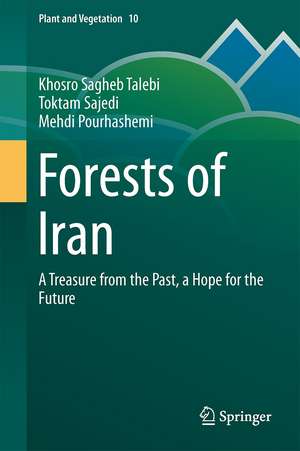Forests of Iran: A Treasure from the Past, a Hope for the Future: Plant and Vegetation, cartea 10
Autor Khosro Sagheb Talebi, Toktam Sajedi, Mehdi Pourhashemien Limba Engleză Hardback – 30 oct 2013
| Toate formatele și edițiile | Preț | Express |
|---|---|---|
| Paperback (1) | 633.84 lei 43-57 zile | |
| SPRINGER NETHERLANDS – 18 sep 2016 | 633.84 lei 43-57 zile | |
| Hardback (1) | 642.83 lei 43-57 zile | |
| SPRINGER NETHERLANDS – 30 oct 2013 | 642.83 lei 43-57 zile |
Din seria Plant and Vegetation
- 18%
 Preț: 1125.86 lei
Preț: 1125.86 lei - 24%
 Preț: 802.94 lei
Preț: 802.94 lei - 18%
 Preț: 953.52 lei
Preț: 953.52 lei - 18%
 Preț: 954.45 lei
Preț: 954.45 lei - 24%
 Preț: 1487.38 lei
Preț: 1487.38 lei - 24%
 Preț: 1329.23 lei
Preț: 1329.23 lei - 24%
 Preț: 962.68 lei
Preț: 962.68 lei - 18%
 Preț: 1405.09 lei
Preț: 1405.09 lei - 18%
 Preț: 1122.42 lei
Preț: 1122.42 lei - 24%
 Preț: 1049.70 lei
Preț: 1049.70 lei - 18%
 Preț: 1222.01 lei
Preț: 1222.01 lei - 18%
 Preț: 1219.16 lei
Preț: 1219.16 lei - 18%
 Preț: 1378.10 lei
Preț: 1378.10 lei - 18%
 Preț: 1230.35 lei
Preț: 1230.35 lei - 18%
 Preț: 1221.38 lei
Preț: 1221.38 lei - 18%
 Preț: 966.78 lei
Preț: 966.78 lei - 18%
 Preț: 959.19 lei
Preț: 959.19 lei
Preț: 642.83 lei
Preț vechi: 756.27 lei
-15% Nou
Puncte Express: 964
Preț estimativ în valută:
123.04€ • 133.70$ • 103.42£
123.04€ • 133.70$ • 103.42£
Carte tipărită la comandă
Livrare economică 21 aprilie-05 mai
Preluare comenzi: 021 569.72.76
Specificații
ISBN-13: 9789400773707
ISBN-10: 9400773706
Pagini: 200
Ilustrații: VIII, 152 p. 86 illus., 55 illus. in color.
Dimensiuni: 155 x 235 x 17 mm
Greutate: 0.49 kg
Ediția:2014
Editura: SPRINGER NETHERLANDS
Colecția Springer
Seria Plant and Vegetation
Locul publicării:Dordrecht, Netherlands
ISBN-10: 9400773706
Pagini: 200
Ilustrații: VIII, 152 p. 86 illus., 55 illus. in color.
Dimensiuni: 155 x 235 x 17 mm
Greutate: 0.49 kg
Ediția:2014
Editura: SPRINGER NETHERLANDS
Colecția Springer
Seria Plant and Vegetation
Locul publicării:Dordrecht, Netherlands
Public țintă
ResearchCuprins
Preface.- Introduction.- 1. Euxino-Hyrcanian province; Caspian and Arasbaran regions.- 2. Irano-Turanian region.- 3. Sahro-Sindian region.
Textul de pe ultima copertă
Iran has a special position in the northern hemisphere because of its rich vegetation and plant diversity, in particular because of its role as a connecting bridge between Europe and Asia. Hence, forests of Iran are a treasure from our natural history in hands of the present generation, but unfortunately the forests of Iran are not that well-known internationally.
Forests, as the richest and complex terrestrial ecosystems, illustrate the past of a country not only from a natural science point of view, but also from historical and cultural aspects. The book aims to make foresters, botanists, ecologists and any other interested persons in other continents familiar with the internationally forgotten forests of Iran. After a brief introduction and describing the general ecological aspects of Iran, this book presents the forests of three main phytogeographical regions of the country. Some issues are given in general, while some others are presented in detail. Similarity of the Caspian forests in northern Iran to those of European, the forests of southern Iran to those of Africa and South Asia, and the forests of western, central and eastern Iran to those of Turkey and Asia Minor explains the relation of Iranian forests to the other forests of the world.
It has been tried to introduce the forests of Iran not only based on the personal knowledge, experiences and researches of the authors, but also based on the experiences of other native forest researchers and scientists. Hence, this book will provide a valuable reference to researchers intrested in ecology of temperate forests as well as in Mediterranean, subtropical and steppic forests of Middle East, in this case of Iran.
Forests, as the richest and complex terrestrial ecosystems, illustrate the past of a country not only from a natural science point of view, but also from historical and cultural aspects. The book aims to make foresters, botanists, ecologists and any other interested persons in other continents familiar with the internationally forgotten forests of Iran. After a brief introduction and describing the general ecological aspects of Iran, this book presents the forests of three main phytogeographical regions of the country. Some issues are given in general, while some others are presented in detail. Similarity of the Caspian forests in northern Iran to those of European, the forests of southern Iran to those of Africa and South Asia, and the forests of western, central and eastern Iran to those of Turkey and Asia Minor explains the relation of Iranian forests to the other forests of the world.
It has been tried to introduce the forests of Iran not only based on the personal knowledge, experiences and researches of the authors, but also based on the experiences of other native forest researchers and scientists. Hence, this book will provide a valuable reference to researchers intrested in ecology of temperate forests as well as in Mediterranean, subtropical and steppic forests of Middle East, in this case of Iran.
Caracteristici
Lack of information and literature in the Middle East region, in particular about forests of Iran, due to its importance in the northern hemisphere Describing the tree species and their ecological characteristics as well as their site demands in three different phytogeographical regions Describing the relation of socio-economic issues and forests different parts of the country, which is very similar to the entire Middle East region












